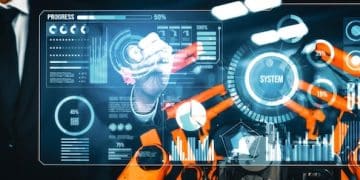AI in Education: Transforming Learning and Classrooms of the Future

The Impact of AI on Education: Personalized Learning and the Future of Classrooms is revolutionizing traditional teaching methods by offering tailored learning experiences, automating administrative tasks, and providing data-driven insights to improve educational outcomes for students of all levels.
The integration of artificial intelligence (AI) into education is no longer a futuristic concept; it’s happening now. The Impact of AI on Education: Personalized Learning and the Future of Classrooms is transforming how we teach and learn, offering personalized experiences and new opportunities for students.
The Rise of AI in Education
The educational landscape is rapidly evolving, and one of the most significant drivers of this change is the increasing presence of artificial intelligence (AI). AI is not just about robots teaching classes; it’s a multifaceted tool that can personalize learning, automate administrative tasks, and provide valuable insights into student performance.
AI-Powered Learning Platforms
AI-powered learning platforms are becoming increasingly popular, offering students customized learning paths based on their individual needs and learning styles. These platforms can adapt to a student’s pace, providing extra support where needed and accelerating progress when appropriate.
The Role of AI in Adaptive Testing
Adaptive testing is another area where AI is making a significant impact. Traditional tests often assess students on a broad range of topics, regardless of their individual strengths and weaknesses. AI-powered adaptive tests, on the other hand, adjust the difficulty of questions based on a student’s performance, providing a more accurate assessment of their knowledge.
- Personalized Learning Paths: AI tailors educational content to individual student needs.
- Adaptive Testing: AI adjusts test difficulty based on student performance.
- Automated Feedback: AI provides instant feedback on assignments.
- Predictive Analytics: AI identifies students at risk of falling behind.

The integration of AI in education is still in its early stages, but the potential benefits are enormous. By personalizing learning, automating tasks, and providing data-driven insights, AI can help create a more effective and engaging educational experience for all students.
Personalized Learning Experiences
One of the most promising aspects of AI in education is its ability to create personalized learning experiences. Traditional classrooms often follow a one-size-fits-all approach, which can leave some students behind while others are not challenged enough. AI can address this issue by tailoring educational content and pacing to individual student needs.
AI Tutors and Virtual Assistants
AI tutors and virtual assistants are becoming increasingly sophisticated, capable of providing personalized instruction and support to students. These AI systems can analyze student performance, identify areas of weakness, and provide targeted interventions to help students improve.
Customized Content Delivery
AI can also be used to customize the way educational content is delivered. Students can learn through a variety of formats, including videos, interactive simulations, and gamified learning experiences. AI can analyze student preferences and learning styles to determine the most effective way to present information.
- AI Tutors: Provide personalized instruction and support.
- Adaptive Content: Adjusts to student’s learning pace and style.
- Gamified Learning: Enhances engagement through game mechanics.
- Personalized Feedback: Offers specific and actionable feedback.
Personalized learning experiences powered by AI have the potential to transform education by creating a more engaging and effective learning environment for all students. This approach ensures that each student receives the support and challenge they need to succeed.
AI-Driven Automation in Education
Beyond personalized learning, AI is streamlining administrative processes within education. Automation of tasks like grading, scheduling, and data analysis allows educators to focus on what they do best: teaching and interacting with students.
Automating Grading and Assessment
Grading papers and assessments can be a time-consuming task for teachers. AI-powered grading systems can automate this process, providing instant feedback to students and freeing up teachers’ time for other tasks.
Streamlining Administrative Tasks
AI can also be used to streamline administrative tasks such as scheduling, attendance tracking, and communication with parents. This can help schools operate more efficiently and effectively.
- Automated Grading: AI grades objective assignments efficiently.
- Administrative Support: AI automates tasks like scheduling and attendance.
- Data Analysis: AI provides insights into student and school performance.
- Communication Tools: AI assists with parent communication.

AI-driven automation can significantly reduce the administrative burden on educators, allowing them to dedicate more time and resources to student instruction and support. This efficiency boost can lead to improved educational outcomes and a more positive learning environment.
The Future of Classrooms with AI
As AI technology continues to advance, the classrooms of the future are likely to look very different from what we see today. AI will play an increasingly central role in shaping the learning experience, from personalized instruction to virtual field trips.
Virtual and Augmented Reality Integration
AI can be combined with virtual and augmented reality to create immersive learning experiences. Students could take virtual field trips to historical sites or explore the human body in three dimensions.
AI-Enhanced Collaboration
AI can also facilitate collaboration among students, providing tools for communication, project management, and peer feedback. This can help students develop important teamwork and communication skills.
- VR/AR Integration: Immersive learning experiences through virtual reality.
- AI-Enhanced Collaboration: Tools for communication and teamwork.
- Predictive Analytics: Identifying at-risk students for early intervention.
- Smart Classrooms: AI managing lighting, temperature, and security.
The future of classrooms with AI is bright, with the potential to create more engaging, effective, and equitable learning experiences for all students. These advancements will require careful planning and implementation to ensure that AI is used in a way that benefits both students and educators.
Challenges and Considerations
While the potential benefits of AI in education are significant, there are also several challenges and considerations that need to be addressed. These include ensuring equitable access to technology, protecting student data privacy, and addressing concerns about job displacement for teachers.
Data Privacy and Security
AI systems collect and analyze vast amounts of student data, raising concerns about privacy and security. It is crucial to implement robust data protection measures to safeguard student information.
The Digital Divide
Ensuring that all students have access to the technology and internet connectivity needed to participate in AI-powered learning is essential. The digital divide could exacerbate existing inequalities in education.
- Data Privacy: Protecting student information in AI systems.
- Equitable Access: Ensuring equal access to technology for all students.
- Teacher Training: Providing educators with the skills to use AI tools effectively.
- Ethical Considerations: Addressing bias and fairness in AI algorithms.
Addressing these challenges will be crucial to ensuring that AI is used in a way that benefits all students and promotes equitable access to quality education and that AI is used ethically and responsibly.
Preparing Educators for the AI Revolution
The successful integration of AI in education requires more than just technology; it requires a shift in mindset and skills for educators. Preparing teachers to effectively use AI tools and adapt their teaching methods is essential.
Professional Development and Training
Providing teachers with professional development and training opportunities is crucial to help them understand and use AI tools effectively. This training should focus on how AI can enhance teaching and learning, rather than replace teachers.
Rethinking Pedagogy
Educators need to rethink their pedagogical approaches to leverage the full potential of AI. This includes incorporating personalized learning strategies, using data to inform instruction, and creating more engaging and interactive learning experiences.
- Professional Development: Training educators to use AI tools effectively.
- Curriculum Adaptation: Integrating AI into existing curricula.
- Collaborative Learning: Encouraging student interaction and teamwork.
- Critical Thinking: Promoting analytical skills in the age of AI.
By investing in teacher training and rethinking pedagogical approaches, we can ensure that educators are well-prepared for the AI revolution and can harness the power of AI to improve educational outcomes for all students.
| Key Point | Brief Description |
|---|---|
| 🚀 Personalized Learning | AI tailors education to individual student needs. |
| 🤖 Automation in Education | AI streamlines tasks like grading and scheduling. |
| 📚 Future Classrooms | VR/AR enhance learning experiences with AI. |
| 🛡️ Challenges & Ethics | Data privacy and equal access must be addressed. |
Frequently Asked Questions
▼
AI-powered personalized learning uses technology to tailor educational content and pacing to meet the unique needs of each student. This approach helps students learn more effectively and at their own pace.
▼
AI automates many administrative tasks in education, like grading papers and managing schedules. This automation frees up teachers’ time, allowing them to focus more on student interaction and lesson planning.
▼
AI in classrooms offers many benefits, including personalized learning, automated administrative tasks, and enhanced engagement through technologies like virtual and augmented reality. It can also help identify struggling students early.
▼
The integration of AI into education faces challenges such as ensuring data privacy, addressing the digital divide to ensure equitable access, and adequately training teachers to use AI tools effectively in their classrooms.
▼
Educators can prepare for AI through professional development and training, where they learn to use AI tools effectively. They should also rethink their pedagogical approaches to incorporate personalized learning and use data to improve their instruction.
Conclusion
The Impact of AI on Education: Personalized Learning and the Future of Classrooms is profound and transformative, offering personalized learning, enhanced collaboration, and streamlined administration. While challenges exist, strategic implementation and preparation can unlock AI’s potential to revolutionize education, creating equitable and effective learning experiences for all students.





